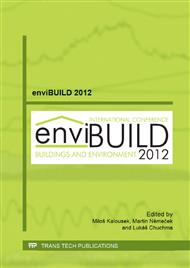p.242
p.246
p.250
p.254
p.258
p.262
p.269
p.273
p.277
The Comparative Analysis of External Walls in a Passive House with Respect to Environment and Energy
Abstract:
The term "passive house" refers to rigorous and voluntary standards for energy efficiency in a building, reducing its ecological footprint. There are many ways how to build a passive house successfully. These designs as well as construction techniques vary from ordinary timber constructions using packs of straw or constructions of clay. This paper aims to quantify environmental quality of external walls in a passive house, which are made of a timber frame, lightweight concrete blocks and sand-lime bricks in order to determine whether this constructional form provides improved environmental performance. Furthermore, this paper assesses potential benefit of energy savings at heating of houses in which their external walls are made of these three material alternatives. A two-storey residential passive house, with floorage of 170.6 m2, was evaluated. Some measurements of air and surface temperatures were done as a calibration etalon for a method of simulation.
Info:
Periodical:
Pages:
258-261
Citation:
Online since:
January 2013
Authors:
Keywords:
Price:
Сopyright:
© 2013 Trans Tech Publications Ltd. All Rights Reserved
Share:
Citation:


